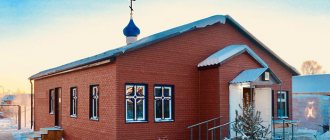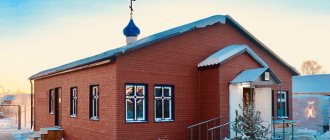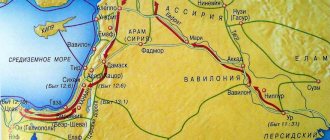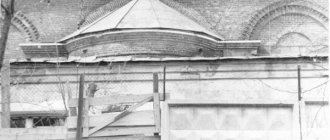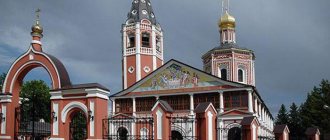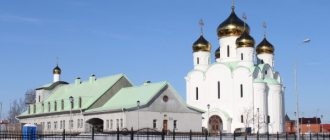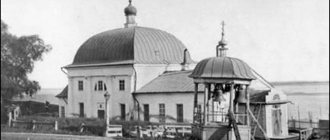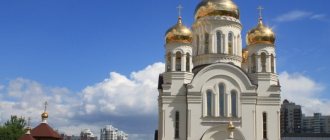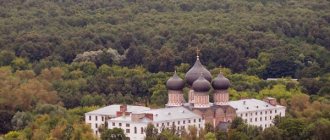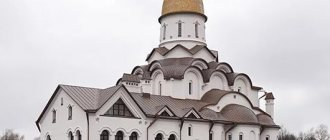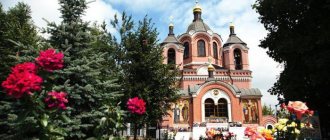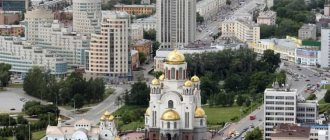| Moscow St. George Church on Poklonnaya Hill |
Moscow Church in the name of the Great Martyr George the Victorious on Poklonnaya Hill
, a patriarchal courtyard within the boundaries of the Moscow diocese
- Throne: martyr. St. George the Victorious
- Address: Russia, 121293, Moscow, st. Victory Square, 3b
- Tel.
- Official site:
- On the map: Yandex.Map, Google map
Located on the territory of the Victory Park memorial complex on Poklonnaya Hill.
Directions: from the Park Pobedy metro station, then walk 650 meters. The parish of the designed church was created no later than 1993. On May 9, 1994, Patriarch Alexy II laid the foundation stone for the future temple. Construction was carried out with city funds from 1994 to 1995.
The opening of the temple was timed to coincide with the 50th anniversary of Victory in the Great Patriotic War. On May 6, 1995, Patriarch Alexy II performed the rite of consecration of the temple in the name of the Great Martyr George the Victorious. The architect of the project was Anatoly Polyansky, but the construction of the temple was completed after his death, with some changes. The iconostasis was made by icon painter Alexander Chashkin, and a little later the temple was completely painted. The famous monumental artist Zurab Tsereteli and mosaic artist Evgeny Klyucharyov equipped the temple with bronze bas-reliefs with mosaic elements.
The temple-chapel of the Archangel Michael was assigned to the St. George Church near the Kutuzovskaya Izba in Fili, at the Memorial Museum of the Patriotic War of 1812. A Sunday school “Rostok” was opened at the Church of St. George, and since 2007 a youth club “Akaluf” has been operating at the churches of the Great Martyr George and the Archangel Michael.
The clergy of the temple also began to spiritually care for the Children's Home for the Disabled No. 15 of the special correctional eighth type for mentally retarded children in the city of Moscow. At the boarding school, a house church was opened in honor of the Kazan Icon of the Mother of God, in which the sacraments of baptism and the Eucharist were performed, prayer services were carried out, and educational activities were carried out with the students.
How to get there
The Church of St. George the Victorious, located in Koptevo, can be reached by public transport from three metro stations:
- From Koptevo station You need to go to the Mikhailovo public transport stop, take trolleybus 27K, get to the Baikal cinema and change to any of the buses: No. 114,179, 204, 282, 461, then get to the Maternity Home No. 27 stop.
- From the Voikovskaya metro station, take trolleybus No. 27, 23, 30 to the Koptevsky Market stop, and then take a walk along Koptevsky Prospekt.
- From the Petrovsko-Razumovskaya station to the stop closest to the temple, Maternity Hospital No. 27, buses 114, 461, 204, 282 and 179 go. The temple is a 10-minute walk from the stop.
Shrines and patronal feasts
Orthodox believers celebrate the day of remembrance of St. George the Victorious on May 6. In Catholicism, this day falls on April 23. In addition, St. George is remembered on November 3, 10 and 26.
Interesting to know! The patronal feast is the day of remembrance of the Saint in whose honor the temple was consecrated.
Relics of St. George's Church:
- image of the Great Martyr George with a particle of relics;
- Icon of the Mother of God “Helper in Childbirth”;
- an icon with a particle of the relics of the Matrona of Moscow;
- an icon with a particle of the relics of Seraphim of Sarov;
- particles of the relics of the Optina elders.
Advice! When praying to icons in the temple, you need to remember that you need to cry out to the Lord and the Saints sincerely. We should also not forget that the Lord is the only one who knows what a person really needs and gives him what he needs. Having received help, we must not forget to thank the Almighty and His helpers for mercy and protection.
History of the temple
The Church of St. George the Victorious in Koptevo was built quite recently by historical standards. But the history of this area goes back hundreds of years.
From wasteland to metropolitan area
The first mention of the Koptevo region dates back to the end of the 16th century, when the fact of the exchange of the village of Toporkovo with the wastelands of Ignatievo and Koptevo for the neighboring settlement of Vladikino was recorded. In the 18th century this area is mentioned in sources under the name of the village of Georgievskoye, named after the owner - the Georgian aristocrat Georgy Vakhtangovich.
After his death, the lands went to the state. At this time, Old and New Koptevo appeared on the map, located south of the original settlement. From the middle of the 19th century. The picturesque area was chosen by the capital's summer residents, which significantly reduced the amount of arable land.
To solve this problem, several peasant families moved to empty lands to the west of the old village. This settlement was named Koptevskie Vyselki.
All 3 Koptev settlements belonged to the parish of the temple located in the village of Vsekhsvyatskoye. But after the construction of the Vindava railway line, residents began to experience difficulties visiting the parish church.
The parishioners decided to build a stone church in Stary Koptevo, dedicated to St. Nicholas the Wonderworker. Perhaps it was built in the area of modern Koptevskaya Street. But according to the testimony of the indigenous residents of the village, by the time the village became part of Moscow, it no longer existed.
Construction of a modern church
After the fall of Soviet power, spiritual life in Russia began to actively develop. Orthodox communities were formed everywhere. In 1996, a similar organization was formed in Koptevo. In the same year, community members decided to build an Orthodox church in Koptevo.
In the last month of winter, the preparatory construction period ended. The territory at the corner of Koptevsky Boulevard opposite Timiryazevsky Park was chosen as the construction site. The design of the church was prepared based on samples of wooden temple architecture of the Russian North. Construction began in 1997 and lasted almost a year.
It was carried out by a team of young craftsmen from Arkhangelsk who had experience in constructing similar structures.
In their work, Arkhangelsk carpenters used ancient technologies and tools, created according to samples of tools of the 16th century. In 2005, professional lighting was installed on the church grounds, which took into account the architectural and decorative features of a modern example of wooden religious architecture.
Today, on the territory adjacent to the Koptevskaya St. George Church, the following buildings are located:
- Church of the Great Martyr George the Victorious;
- church in the name of 14,000 infants killed by Herod in Bethlehem;
- Sunday School;
- Church shop;
- Parish library.
Exterior decoration
St. George's Church in Koptevo is an example of a multi-domed wooden church that spread in the northern Russian lands in the second half of the 17th century. The main volume of the building is a wooden frame in the shape of an octagon, covered with a tent.
It is decorated with a bulbous head placed on a small narrow drum. Adjacent to the main part are 4 two-story porches, the roof of which is made in the shape of a barrel. The extensions, oriented to the cardinal points, are topped with drums with onion-shaped heads.
On the eastern side of the temple there is a rectangular apse with a barrel-shaped ceiling, which is also crowned with an onion dome. Adjacent to the western porch is the refectory part of the temple - a log house in the form of an elongated rectangle with a gable roof.
Church of St. George the Victorious in Koptevo from the outside
Above this volume there is a small bell tower. It is made in the form of a two-tier octagon with a hipped ceiling, which ends with an onion dome. The second tier is made in the form of an open veranda, fenced with an openwork balustrade.
The Church of St. George the Victorious, built in Koptevo, has 3 porches. The main western entrance to the church is made in the form of a wide porch with a gable roof, on which stands a low drum with a small dome. Two small porches lead to the northern and southern porch, adjacent to the main volume.
The domes, drums and roofs are covered with ploughshares - small teardrop-shaped planks. Window casings, roof frames and railings are decorated with elegant carved details.
Interior decoration
All the main parts of the interior of the temple are made of wood and decorated with openwork carvings. Its main part is a 5-tier iconostasis, made of larch and decorated with carvings.
The Solea is enclosed by an elegant balustrade. Above the pulpit, located opposite the royal doors, there is a carved prologue, which is supported by four figured tables. Opposite the iconostasis on the 2nd floor level there is a room for the choir.
There are numerous icons on the smoothly hewn walls of the temple. Some of them are in simple wooden frames, others - the most revered - are placed in icon cases, richly decorated with carved wooden ornaments. To the left of the iconostasis, near the Mother of God icon of the Helper in Childbirth, there is a small side altar, consecrated in honor of this image.
The Church of St. George the Victorious in Koptevo has a natural and artificial source of consecration. Sunlight enters the room through small windows located on the second and third floors. Artificial lighting is provided by electric lamps, resembling candles, inserted into a copper candlestick.
The Church of St. George burns in the fire of 1812
After the Battle of Borodino, the Russian army retreated and left deserted Moscow to be plundered by Napoleon's troops.
Moscow was burned. However, the set fire to the capital also became a trap for the enemy forces. During this treacherous maneuver, many honest people died who did not have time to leave the city, and almost all buildings were damaged. The Church of St. George was no exception, although the building itself suffered little damage, only the cemetery collapsed.
However, the fire greatly affected the interior decoration of the temple. The altar and iconostasis were damaged, almost all the painting was burned out. In addition to damage from fire, the temple suffered at the hands of looters. Some of the church utensils were stolen by hitmen and disappeared in an unknown direction.
1825
this year the restoration of St. George's Church began after the War of 1812
The church began to be restored only in 1825. The renovation took almost four years. The ruins of the cemetery were removed, the interior walls were re-painted, and the damaged altar was gilded.
In 1829, the renovated church was reopened to parishioners. The temple acquired its modern appearance only in 1862, when funds were allocated for its expansion. The gallery connecting the bell tower and the temple was removed. In its place two chapels were erected. The southern one was dedicated to the Monk Theodore Skiot, the northern one to Nil Stolobensky.
After the February bourgeois revolution, the Russian Orthodox Church again gained independence from the royal will
Shrines located in the temple
The following relics are kept in St. George's Church:
- temple image of St. George the Victorious with a particle of relics;
- the revered icon of the Most Holy Theotokos Helper in Childbirth;
- icon of Spyridon of Trimifun;
- an icon with a particle of the relics of St. Seraphim of Sarov;
- the image of the Matrona of Moscow and a particle of her holy relics;
- reliquary with particles of the Optina elders.
Icon of St. George the Victorious
The temple in Koptevo was erected in the year of the celebration of the 850th capital. Therefore, they dedicated it to the heavenly patron of the city - the Holy Great Martyr George the Victorious.
One of the especially revered Orthodox saints lived at the end of the 3rd - beginning of the 4th centuries. He was born into a Christian family.
Having entered military service, he quickly advanced through the ranks and became one of the close associates of Emperor Diocletian, an ardent pagan and persecutor of Christians.
Having learned about the young warrior’s commitment to Christianity, the ruler subjected him to many tortures.
But faith in the Power of the Lord helped George overcome all bodily suffering. Unable to convert the warrior to paganism, the emperor ordered his beheading.
The temple icon of the Koptevsky temple, located in the first tier of the iconostasis, depicts Saint George riding a white horse, slaying a dragon (snake) with a spear.
This plot is based on the posthumous miraculous appearance of a saint who killed a serpent, to which the inhabitants of a settlement near Berit were making human sacrifices.
Some theologians interpret this apocryphal episode as the victory of the great martyr over paganism attacking the Christian church.
On the right wall of the central part of the temple there is a half-length icon of St. George the Victorious, the iconography of which dates back to the first images of the holy warrior. On it, the great martyr, dressed in a red cloak and chain mail, holds a sword and spear in his hands.
People come to the images of St. George to pray for the following:
- on the protection of soldiers and their families;
- about assistance in farming;
- on the prevention of natural disasters;
- about getting rid of diseases in domestic animals.
Icon of the Most Holy Theotokos Helper in Childbirth
One of the main shrines of the Church of St. George the Victorious in Koptevo is the icon of the Most Holy Theotokos “Helper in Childbirth”. It is located to the left of the iconostasis in the main part of the temple. In honor of this image of the Mother of God, an additional altar was consecrated, used during several liturgies per day.
The “Helper to Wives” is addressed with the following prayer requests:
- help overcome infertility;
- facilitate the course of pregnancy and childbirth;
- about the safe birth of a healthy and strong baby;
- about giving peace in the soul, physical and spiritual strength;
- gratitude for the birth of a long-awaited child.
The revered icon from the Koptevsky temple is a half-length image of the Mother of God, dressed in a green shirt and maforium of the same color.
At the level of her chest is an image of the baby Jesus, whose right hand is raised in a gesture of blessing. The image is placed under a carved wooden canopy.
Icon of the Blessed Matrona of Moscow
The Church of St. George the Victorious in Koptevo is one of the places where the icon of Mother Matrona of Moscow with a particle of relics is kept. It is located next to the southern exit of the temple. The blessed old woman is depicted in a simple green shirt with a white scarf on her head.
The hands are folded on the chest in a prayer gesture and the eyes are closed. Matrona of Moscow is the only saint who is depicted on icons with her eyes closed. This is evidence that, not being able to see the bodily shells of people, she looked into their souls with spiritual vision, read their thoughts and intentions.
You can contact the Holy Mother with a prayer request of any content.
But more often people ask for the following:
- help in family troubles;
- help solve financial difficulties;
- take care of the children
- recognize deception;
- cure various diseases.
When coming to a temple to pray to any holy image, you must remember the following:
- Only a sincere, pure request coming from the soul will be fulfilled;
- The Lord often gives a person not what he asks for, but what he needs most at that moment;
- Having received help in your request, you need to thank the Lord and the Saint for your help.
Art. 39-46 And going out, he went as usual to the Mount of Olives, and His disciples followed Him. Having arrived at the place, he said to them: Pray so as not to fall into temptation. And He Himself departed from them a stone's throw, and, kneeling down, prayed, saying: Father! Oh, that You would deign to carry this cup past Me! however, not My will, but Yours be done. An angel appeared to Him from heaven and strengthened Him. And, being in struggle, he prayed more diligently, and His sweat was like drops of blood falling to the ground. Rising from prayer, He came to the disciples and found them sleeping from sadness and said to them: Why are you sleeping? stand up and pray that you will not fall into temptation. After the supper, the Lord does not indulge in inaction, pleasure and sleep, but teaches and prays, giving us a model and example for this. Therefore, woe to those who, after dinner, turn to shameful acts of fornication. Having taught the disciples this, the Lord ascends the Mount of Olives to pray. He liked to do this alone, so he also leaves his students. However, He takes with Him disciples, but not all of them, but only those three who saw His glory on the mountain (Luke 9:28). Since He is in struggle and prays, so that this does not seem a sign of fear, He takes those who have themselves seen His Divine glory and have themselves heard the testimony from heaven, so that, seeing Him in struggle, they consider this a matter of human nature. For to ensure that He was truly Man, He allowed this nature to act in its own way. As a Man, He desires to live and prays for the cup to pass, for man is a lover of life; and through this he overthrows the heresies, according to which He became ghostly man. For if even after such actions (human nature) they found a reason to talk idle talk in this way, then why would they not have punished them if these actions had not happened? So, the desire for the cup to be carried past belongs to human nature, and soon after that the words spoken: however, “not my will, but yours be done” show that we must have the same disposition and also philosophize, submit to the will of God and not to deviate, even if our nature draws us in the opposite direction. “Not My” human “will, but Yours be done,” and this Yours is not separated from My Divine will. The One Christ, having two natures, had, without a doubt, the will or desires of each nature, Divine and human. So, human nature first wanted to live, for this is characteristic of it, and then, following the Divine will for all people to be saved, the will common to the Father and the Son and the Holy Spirit, it decided to die, and thus one desire became a saving death. That the prayer was from human nature, which, by assumption, had a passion for life common to all, and not from the Divine, as the damned Arians say, this is evident from the fact that Jesus was in sweat and such struggle that, as the proverb says, drops fell from Him blood. For those who work hard are usually said to sweat blood, just as those who lament bitterly are said to cry blood. Wanting to show this, namely, that it was not some thin liquid flowing from Him that seemed to be showing for appearances, but large drops of sweat were falling, the evangelist used drops of blood to depict reality. Hence it is clear that the nature that exuded sweat and was in struggle was human, and not Divine. For human nature was allowed to experience such states, and it experienced it in order, on the one hand, to show that He was not a ghostly man, and on the other, a hidden goal, in order to heal the timidity common to human nature, having exhausted it in Himself and subjugating it the will of God. - Another may say that the sweat coming out of the body and falling to the ground means that, with the encouragement and strengthening of our nature in Christ, the sources of timidity in us evaporate, turn into drops and fall from us. For if He did not have this in mind, that is, the desire to cure our human timidity, He would not have sweated so much, even though He was very timid and cowardly. “An angel appeared to Him from heaven and strengthened Him.” And this is for our consolation, namely: so that we recognize the strengthening power of prayer and, having learned it, turn to it in case of misfortunes. At the same time, the prophecy of Moses, spoken in the great song, is also fulfilled: “and may all the sons of God be strengthened” (Deut. 32, 43). Some explained these words in such a way that an Angel appeared to Him, glorified Him and said: Thine, O Lord, is the strength! For You have overcome death and hell and freed the human race. This is so, - He, having found the disciples sleeping, reprimands them and together convinces them to pray in temptations, so as not to be overcome by them. For not to fall into temptation means not to be consumed by temptation, not to fall under its power. Or he simply commands us to pray that our property will be safe and that we will not be exposed to any trouble. For to plunge oneself into temptations means to be courageous and proud. How does James (1:2) say: “Count it all joy when you fall into various temptations”? What is this, aren’t we contradicting ourselves? No, for Jacob did not say: plunge yourself, but when you are exposed, do not lose heart, but have all joy and make the involuntary free. For it would be better if temptations did not come, but when they did come, why be madly sad? - Can you show me a place in Scripture where it is literally commanded to pray in order to fall into temptation? But you can't put your finger on it. “I know that there are two types of temptation and that some people have a duty to pray about not falling into temptation; they mean temptation that overcomes the soul, for example, the temptation of fornication, the temptation of anger. And we should have all joy when we are exposed to bodily illnesses and temptations. For to the extent that the outer man decays, the inner man is renewed (2 Cor. 4:16). Although I know this, I prefer what is more true and what is closer to the real goal.
Art. 47-53 While He was still saying this, a crowd appeared, and ahead of them walked one of the twelve, called Judas, and he came to Jesus to kiss Him. For he gave them this sign: Whomever I kiss, He is the one. Jesus said to him: Judas! Do you betray the Son of Man with a kiss? Those who were with Him, seeing where things were going, said to Him: Lord! Shouldn't we strike with a sword? And one of them struck the servant of the high priest and cut off his right ear. Then Jesus said: Leave it, enough. And touching his ear, he healed him. Jesus said to the chief priests and rulers of the temple and the elders who had gathered against Him, “As if you had come out against a thief with swords and staves to take Me?” Every day I was with you in the temple, and you did not raise your hands against Me, but now is your time and the power of darkness. Judas signaled a kiss to those approaching Jesus, but so that they would not be mistaken because of the night, he did not indicate from afar. - So that Jesus does not hide, for this purpose they come with lanterns and lamps. - What about the Lord? He allows you to approach Him with this enemy kiss. And the thunder arrows did not wake up in the ungrateful and treacherous! Thus, the Savior teaches us kindness in such circumstances. He only says reproachfully: “Judas! Do you betray with a kiss? Aren't you ashamed of the very sight of betrayal? Why do you mix betrayal, the enemy’s work, with a friendly kiss? And who are you betraying? “Son of Man,” that is, humble, meek, condescending, who became human for your sake, and, moreover, the true God. He says this because until recently he was in love with him. Therefore, he did not offend him, did not call him inhuman and extremely ungrateful, but called him by his own name: “Judas.” And he would not reproach him if this did not serve to improve him, if he so desired. For He did this and, apparently, reproached him so that Judas would not think that He would hide, but so that, at least now, having recognized Him as the Master, as the Omniscient, He would fall to Him and repent. The Lord knew that Judas was incorrigible, however, he did His own, just as His Father did in the Old Testament; He knew that the Jews would not listen, however, he sent prophets. And at the same time he teaches us this very thing, namely: so that we are not offended when correcting those who fall. — The students are inflamed with jealousy and draw their swords. Where did they get them from? It was natural for them to have them, since they had previously killed the lamb and left the table. But the hot-tempered Peter receives a reproach because he used jealousy contrary to the Lord’s intention. While others ask whether we should strike, he does not expect approval (how ardent he was everywhere for the Teacher!), but strikes the servant of the high priest and cuts off his right ear. This did not happen by chance, but as a sign that the high priests of that time had all become slaves and lost their correct hearing. For if they had listened to Moses, they would not have crucified the Lord of glory (John 5:46). Jesus puts in his ear; for it becomes the great power of the Word to heal the disobedient and to give them an ear to hear. Jesus performs a miracle in order to show His kindness by this visible miracle above the ear and, at least by a miracle, to lead them to the idea of restraining themselves from rage. - Speaks to the high priests and “chiefs” of the temple, that is, to the stewards appointed to satisfy the demands of the priests; or he calls those who were entrusted with the construction and decoration of the temple as bosses. He says to them: I taught every day in the temple, and you did not want to take Me, but now you have come as against a robber. However, you are truly undertaking the works of the night, and your power is the power of darkness. Therefore, you have definitely chosen a time that is suitable for both you and the business you are undertaking.
Art. 54-62 They took Him and led Him away and brought Him to the house of the high priest. Peter followed from afar. When they had lit a fire in the middle of the courtyard and sat down together, Peter sat down between them. One maid, seeing him sitting by the fire and looking at him, said: “This one was with Him too.” But he denied Him, saying to the woman: I do not know Him. Soon after, another, seeing him, said: “You too are one of them.” But Peter said to the man: No! About an hour passed, and someone else insistently said: Surely this one was with Him, for he was a Galilean. But Peter said to the man, “I don’t know what you are saying.” And immediately, while he was still speaking, the rooster crowed. Then the Lord turned and looked at Peter, and Peter remembered the word of the Lord, how He said to him: before the rooster crows, you will deny Me three times. And, going out, he wept bitterly. Peter, according to Christ’s prediction, turned out to be weak and denied the Lord Christ not once, but three times, and denied with an oath, for Matthew says: “Then he began to swear and swear that he did not know this Man” (Matthew 26:74). Perhaps such timidity took possession of him, and he was left for some time for his daring, as if to teach him so that he would be lenient towards others. For he was very bold, and if he had not been humbled by this circumstance, he would have acted in many ways autocratically and without condescension. But then he fell into such horror that he would not have felt the fall if the Lord had not turned and looked at him. O goodness! He himself is under condemnation, but cares about the salvation of the student. And fair enough. For He endured the very condemnation for the salvation of man. “First the student denied, then the rooster crowed. He again denied, even up to three times, and the rooster crowed again another time. Mark describes this precisely and in detail (chapter 14) and conveys it as having learned it from Peter, for he was his disciple. And Luke, since Mark said this, spoke briefly, without going into details. And Luke's words do not contradict what Mark said. For the rooster has a custom of crowing two or three times for each meal. So, Peter was brought into such oblivion by human weakness that he did not come to his senses even at the crowing of the rooster, but even after the rooster crowed, he denied it again, and again, until the benign glance of Jesus brought him to his memory. - “And, going out, he wept bitterly.” Mark says that Peter came out even after the first denial (Mark 14:68). Then it was natural for him to enter again, so as not to give rise to greater suspicion that he was Jesus’. When he came to his senses again, he came out and cried bitterly. And in order not to be noticed by those in the yard, he goes out secretly from them. “Some, I don’t know why, put up an insane defense in favor of Peter, boldly saying that Peter did not deny, but said: I do not know this “man,” that is, I know not as a simple man, but as God made Man. Let's leave this crazy argument to others. For they represent the Lord as false, contradict the connection of the Gospel speech and cannot in any way agree on the order of the narrative. And why should Peter cry if he did not renounce?
Art. 63-71 The people who held Jesus mocked Him and beat Him; and, covering Him, they struck Him in the face and asked Him: Prophesy, who struck You? And many other blasphemies were uttered against Him. And when the day came, the elders of the people, the high priests and the scribes, gathered together, and brought Him into their Sanhedrin and said: Are you the Christ? tell us. He told them; if I tell you, you won’t believe it; Even if I ask you, you will not answer Me and do not let Me go, from now on the Son of Man will sit at the right hand of the power of God. And they all said: So, are you the Son of God? He answered them: you say that I am. And they said: what more evidence do we need? for we ourselves have heard from His mouth. Those who did this to Jesus were some scolders and unbridled people; for it was necessary that the devil should not abandon a single form of malice, but pour out all of it, so that our nature, being holy in everything, would defeat and trample upon him.
Since the Lord took on our nature in order to strengthen it against all the tricks of the devil and to show that initially Adam would not have been defeated if he had been alert, therefore, when all types of the devil’s malice are poured out on Him, He endures so that we would subsequently take courage , knowing that our nature was victorious in Christ, and did not shy away from anything that was apparently offensive and bitter.
Therefore He endures ridicule and beatings and, being the Lord of the prophets, is ridiculed as a false prophet. For the words: “prophesy” to us, “whoever struck You,” refer to him in order to ridicule Him as a deceiver, and yet arrogating to Himself the gift of prophecy. “And how the day came.”
Drunken servants ridiculed and slandered Jesus Christ at night. And during the day the elders and honorable people ask: Is this the Christ? Knowing their thoughts and the fact that if they do not believe deeds, which are more powerful in convincing, they will certainly not believe words, He says: even if I tell you, you will not believe. For if you believed My words, what need would there be for a real meeting? Even if I ask, you won’t answer. For they often remained silent when asked questions, for example, about the baptism of John (Mark 11:33), about the words: “The Lord said to my Lord” (Matthew 22:44), about the bowed woman (Luke 13:11). When did you listen to Me and believe? When did you not remain silent when asked a question? Therefore, I will only say that from now on it is not the time to tell you and explain who I am (for if you wished, you would have known Me from the signs I performed), but from now on it is the time of condemnation. You will see Me, the Son of Man, sitting “at the right hand of the power of God.”
At this, one should be afraid, but after such words they became even more furious and frantically asked: “So, are you the Son of God?” He, with moderation and pointing out the incongruity of their question, answers them: you say that I, for He despised their rage, spoke to them undaunted. Hence it is clear that the stubborn do not receive any benefit from the fact that secrets are revealed to them, but receive much greater condemnation. Therefore, it should be hidden from such people, for this is a more humane matter.
Art. 1-5 And the whole multitude of them rose up, and led Him to Pilate, and began to accuse Him, saying: We have found that He corrupts our people and forbids giving tribute to Caesar, calling Himself Christ the King. Pilate asked Him: Are you the King of the Jews? He answered him: You speak. Pilate said to the chief priests and the people: I find no guilt in this man. But they insisted, saying that He was disturbing the people by teaching throughout all Judea, starting from Galilee to this place. Apparently they contradict the truth. For where did Jesus forbid paying taxes, when He, on the contrary, commanded to pay them as due? It was He who said this: “render unto Caesar the things that are Caesar’s” (Luke 20:25). How does He anger the people? Is he not seeking the Kingdom? But no one believed this. For even then, when the people wanted to make Him king, He, having learned about this, withdrew (John 6:15). Therefore, Pilate, realizing the slander, openly says: I do not find any guilt in this man. “In my opinion, the very question he makes of Christ is a mockery of slander. For saying: Are you the King of the Jews? — he mocks the matter itself. He says something like this: You, wretched, poor, naked, helpless, are accused of striving for royal power. And this, as we said, is a mockery of those who accuse Jesus of this, that they imagine such a helpless and such a poor man to be plotting such a thing, for which both fortune and assistants are needed, and they, having nothing else to confirm the slander, use the work of voices and shouts against God the Word, “He corrupts,” they say, “that is, he outrages the “people,” and not in one particular place, but began from Galilee and, passing through the middle of Judea, managed to outrage to this place. It seems to me that they mentioned Galileo for a reason, but with the intention of bringing Pilate into fear. For Galileans are always like that, rebellious and prone to innovation, just like Judas the Galilean. It seems that they reminded Pilate of him, saying something like this: ruler, compare Judas the Galilean, who caused a lot of trouble to the Romans, outraged a considerable part of the people. Such is this One, Who must be destroyed immediately.
Schedule of services
| Day of the week | Time | Type of service | Peculiarities |
| Monday | 9.00 17.00 | Divine Liturgy. Prayer service. Vespers. Matins. Confession. | |
| Tuesday | |||
| Wednesday | At the evening service, an akathist to the Mother of God is read. | ||
| Thursday | Prayer for the sick. | ||
| Friday | All-night vigil. | ||
| Saturday | 7.00 10.00 17.00 | Early Divine Liturgy. Late Divine Liturgy. Vespers. Matins. Confession. | |
| Sunday | At the evening service, an akathist is read to the Holy Great Martyr George the Victorious. |
On general church and patronal holidays, it is possible to change the church's work schedule, which can be found out in the information service.
Patronal holidays[edit]
St. George the Victorious, Great Martyr
- the 6th of May
Annunciation of the Blessed Virgin Mary
— April 7
Nile Stolobensky - June 9 [according to modern times] (finding of relics), December 20 [according to modern times] (day of death)
New Martyrs and Confessors of the Russian Church - February 7 [according to current times]
St. Theodora Sikeota - May 5 [according to modern times] (day of repose), June 28 [according to modern times] (transfer of relics)
Parish activities
In addition to spiritual service, the clergy of the St. George Church conduct active social activities aimed at the spiritual, cultural and physical development of children and youth. As part of this work, at the parish of the Church of St. George
The following organizations operate in Koptevo:
- choir chapel “Victoria” for children;
- amateur and professional adult choir;
- dance group “Dream”
- hand-to-hand combat sections for children and adults;
- sections of historical and modern sword fighting;
- football section;
- family and children's tourism clubs;
- tourism instructor training courses;
- art lovers club.
The clergy and parishioners of the temple carry out social activities.
These include:
- providing social assistance to people in need;
- the activities of the sisterhood of Spyridon of Trimifunsky in the bordering of a number of medical institutions;
- support for orphanages;
- humanitarian assistance to residents of remote Russian parishes.
The parish regularly organizes pilgrimage trips to holy places, educational and entertaining excursions for children and youth. Together with other parishes of the Northern, Northwestern and Western Vicariate, a children's summer camp “Young Academician” was organized.
Rules of behavior in the temple
The temple is the house of the Lord, where a person comes to communicate with him through holy prayer.
When attending a church service, you must adhere to rules that can be divided into several groups:
- Behavior of an adult in church.
- Features of visiting church with children.
- Appearance requirements.
Behavior in church for an adult:
- You should come to the temple some time before the start of the service in order to calmly light candles, bow to the icons and take a comfortable place.
- It is imperative to turn off mobile phones.
- A person who comes after the start of the liturgy should quietly enter the room and greet familiar people with a slight nod, without distracting them with conversation. You should not walk around the temple during worship, as this prevents the rest of the parishioners from concentrating on reverent, humble prayer.
- Orthodox Christians participate in worship while standing on their feet. Moreover, according to tradition, men are located to the right of the Royal Gate, and women to the left of them. Only weak people can sit down.
- During the service, general prayers should be read. They must come from the heart. It must be remembered that at this moment the Lord and all the holy saints look at the person.
- You cannot leave the church until the end of the liturgy. You can leave in case of emergency, then repent of this act in confession.
Rules for parents with children:
- Before visiting the temple, children should be explained that they are not allowed to talk loudly, shout or run around in it. If the child has not yet been to church, then he should come here in advance to answer all the questions he has about the decoration of the temple and the upcoming action.
- If a child screams during a service, he is quietly taken out of the room and calmed down.
- Even children cannot eat or drink in church (except for communion with bread).
Appearance requirements:
Men and women come to the temple with thoughts about the soul and spiritual improvement. Therefore, the appearance should be modest. Women must wear a skirt or dress that covers the knees and shoulders. There should be no makeup on your face.
It is especially necessary to refrain from using lipstick. The head must be covered. Men, on the other hand, must remove their hats and sunglasses. They are not allowed to enter the church wearing shorts or sleeveless T-shirts.
Often local traditions develop in churches that are not contained in the Church Charter. Following them is not mandatory, but you should not argue with the parishioners who made the remark. They should be listened to humbly and apologized for the mistake.
The Church of St. George the Victorious, in the capital's Koptevo district, is not only the center of the spiritual life of local parishioners, but also a striking monument of wooden temple architecture. The active social and educational work of church clergy is supported not only by local parishioners, but also by church visitors from other districts of the capital.
Article design: Vladimir the Great
The last rector of the Church of St. George, Vladimir Proferansov, was ranked among the new martyrs
In August 2000, the anniversary congress of the Bishops' Council of the Russian Orthodox Church took place. One of the topics was the acceptance of the new martyrs and confessors of Russia. Among others, the last rector of the church, St. George, Archpriest Vladimir Proferansov.
Father held the important post of secretary of Patriarch Tikhon. When people from the NKVD came to him and offered cooperation. The archpriest refused. He was arrested, then convicted and sent into untimely exile.
December 15
official day of remembrance of the new martyr Vladimir Lubyansky
In 1937, Vladimir’s father was sent by convoy to the Butovo training ground, where OBKOM troikas were working at that moment. From one of these groups, an archpriest was sentenced to death.
December 15 became the official day of memory of Vladimir Lubyansky. Moreover, commemoration of the saint began in the same year 2000. The icon of the holy martyr was painted for this date. However, it was only in 2007 that a full-fledged celebration was held in honor of St. Vladimir Lubyansky for the first time.
By leaving a comment, you accept the user agreement
